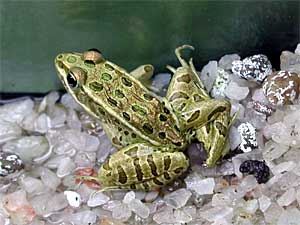|
Photos
More from MPR
Resources
Your Voice
|
Frog researcher invited to tell his story
October 26, 2004
 |
| This frog has deformed legs, and research conducted by a professor in California links such deformities to the use of atrazine, a common corn herbicide. (Photo courtesy of MPCA) |
St. Paul, Minn. — Researcher Tyrone Hayes told the Senate Environment and Natural Resources Committee that his studies looked at laboratory frogs grown in water that contained extremely low levels of atrazine -- .1 part per billion. That's the equivalent of one one-thousandth of a grain of salt in an aquarium tank.
At those levels, Hayes found startling results. Male frogs were "chemically castrated." That is, atrazine disrupted the animal's ability to produce testosterone. Hayes says atrazine poses a risk to humans as well as frogs.
"Those genes are being turned on and off by hormones -- thyroid hormones, testosterone, estrogen -- stress hormones that are chemically exactly the same hormones that circulate and regulate the development and physiology of everybody in this room, all vertebrates," Hayes says. "So maybe amphibians are more sensitive, because they have no membranes or eggshells to protect them. But because the hormones that are being interfered with occur in all vertebrates, maybe they're telling us its just a matter of time."
 | |||
Hayes says more recent research has shown atrazine and other pesticides can cause the limb deformities in frogs first seen by Minnesota school children in 1995. The chemicals increase stress hormones and alter the transition from tadpole to frog. They can also make frogs more susceptible to parasites that cause extra limbs.
Hayes cited other studies showing that atrazine disrupts hormone systems in fish, birds, and rodents. Studies in rats have also shown a link between atrazine and mammary cancer. A study of workers in an atrazine factory showed a link between atrazine and prostate cancer.
In response to Hayes' frog research, the chemical industry funded an array of studies over the years. Then, the industry issued statements saying Hayes' work could not be replicated.
In his presentation, Hayes showed data from a soon-to-be published survey of his own, showing the studies that said there was no problem were all funded by Syngenta, the Swiss company that makes atrazine. The studies that did show problems were funded by the National Science Foundation, the National Institutes of Health, various universities, the Japanese and Canadian governments, and others. Atrazine was banned last year by the European Union.
|
Professor Hayes charges that the federal Environmental Protection Agency is accepting flawed industry-funded studies as evidence, and giving undue weight to industry concerns, as it makes regulatory decisions about atrazine.
|
Hayes also charged that the federal Environmental Protection Agency is accepting flawed industry-funded studies as evidence, and giving undue weight to industry concerns, as it makes regulatory decisions about atrazine.
Sen. John Marty, who chaired the hearing, says that disturbs him.
"They allow the industry to step in there and provide phony information, distorted information, that prevents them from taking any regulatory action," says Marty.
Marty says he's worried the Minnesota Pollution Control Agency is taking a similar road. Recently, the agency invited Hayes to be a keynote speaker at an upcoming conference, then "uninvited" him after he refused to remove the words "atrazine" and "pesticide" from the title of his talk.
The MPCA said Hayes has presented his research at previous conferences and that Commissioner Sheryl Corrigan simply decided there wasn't enough new material to warrant a featured speaking spot.
Environmentalists sent a letter of protest to the MPCA and said Monday they would continue to press the agency to restore Hayes' role as the top speaker.
Agency spokesman Ralph Huessner reiterated that Hayes would be formally invited to attend the conference but wouldn't give the keynote address. He would, however, have a chance to present his findings, Huessner said.
Marty told reporters he may push for a ban on the chemical next session.
The Minnesota Health department plans to lower the state's limit for atrazine in drinking water. The department's proposed new level is four parts per billion, which is still above the limits set by the U.S. EPA, the World Health Organization, and the state of California.
Pam Shubat, an environmental toxicologist with the Minnesota Health Department, says the new Minnesota standard is based on data from studies that assess the risk to mammals, but she says the guidelines are still a work in progress.
"This is our best attempt. They are out there for comment and we welcome comment on them," says Shubat.
Minnesota law does require public drinking systems to remove atrazine to lower its levels to three parts per billion, which is still many times the level that causes deformities in frogs.
Lower atrazine limits for Minnesota water could lead to changes for farmers. The state Agriculture Department requires farmers to use "best management practices" designed to keep farm chemicals out of water. In 2003, the last year for which figures are available, Minnesota farmers applied more than three million pounds of atrazine.
(The Associated Press contributed to this report)
|
News Headlines
|
Related Subjects
|
